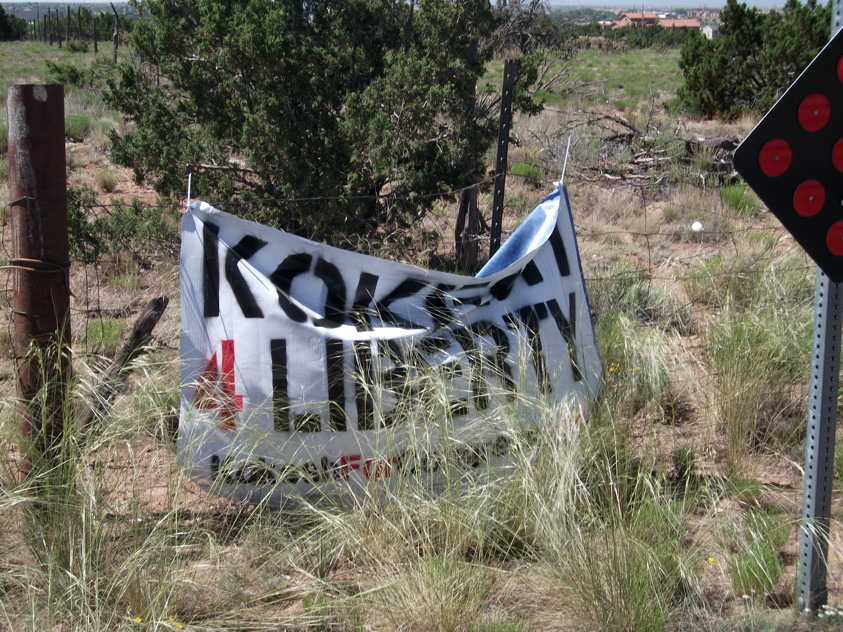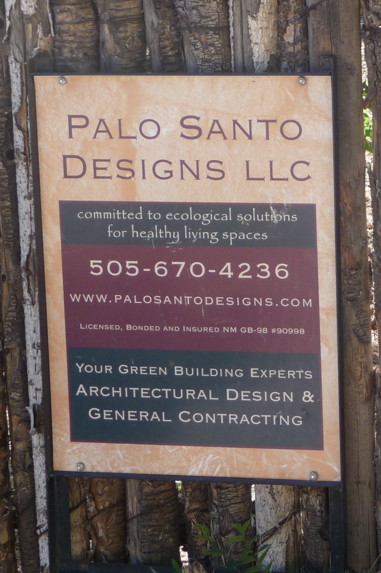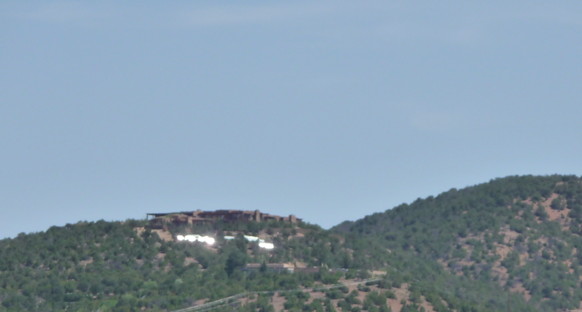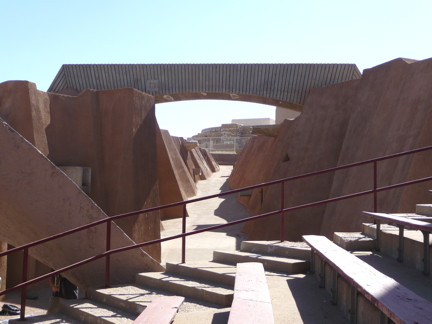
After the June primary (on West Alameda Street). Photos by George Johnson
Santa Fe Restyle
This afternoon while the construction crew was off for the weekend, I walked through the ruins of my neighbor Eduardo’s old house. He lived across the street from me, one of three brothers who grew up on this end of the block. For 17 years when I went down to my mailbox, I’d see him working in his yard. He told me stories about the old neighborhood — gathering firewood in the Arroyo Chamiso, swimming in the river, or ice skating on the frozen reservoir on the hill behind his house, the one where the fashion designer Tom Ford is still building his mansion. When Eduardo died about a year ago, the last of the brothers to survive, the neighborhood was diminished. His house was sold to a couple from Houston, and a few months ago the parade of backhoes and construction trucks began.
The digging has been relentless: eight-hour shifts of jackhammering, the mechanical scooping and dumping of tons of rock to be hauled away. The work had been going on for so many weeks that I imagined they were excavating a swimming pool, a wine cellar, some vast underground chambers. But no. All of this commotion was just to make room for a foundation so the back of the house could be expanded into the hillside. I wondered if the contractor (“Your Green Building Experts”) knew that they would be chipping inch by inch, dollar by dollar, through solid bedrock.
Eduardo, a very shy man, had never invited me into his house. Now with the doors and windows removed and the walls stripped bare, I took a walk inside. It had been a charming, modest home, built of real adobe made on site — you can see the rocks in a few spots where the outer walls have been exposed. If the new addition to the house is also adobe, the bricks will be carted in readymade from a factory. All that earth hauled away so that different earth can be hauled in. Nobody used to build houses this way. What Eduardo had owned and lovingly cared for was true Santa Fe style before it became commoditized.
Every morning after it rained, he would be outside with a shovel scooping his driveway back onto the hill. Now his son, another good neighbor whose house is behind his father’s, has taken over the task. After last week’s downpour, I was getting ready to drive downtown when I saw him out in the street combating the erosion. The new owners, a husband and wife, had come by to check on things, and the man had picked up a shovel to help fill a deep rivulet. “Nice rain,” I called out as I backed my car onto the street. The woman grimaced.
I had only meant to be friendly. There is much to learn when one moves to Santa Fe: how rain is not something to complain about, and a driveway on a hill might always be a work in progress.
George Johnson
The Santa Fe Review

Sustainability Summer School
 Almost every morning for the last two weeks, I’ve driven up the hill to St. John’s College to sit in on an event, sponsored by the Santa Fe Institute, called Sustainability Summer School. And every morning as I depart, the jackhammering and scraping of rock against steel has continued as the couple from Houston builds a “green” home.
Almost every morning for the last two weeks, I’ve driven up the hill to St. John’s College to sit in on an event, sponsored by the Santa Fe Institute, called Sustainability Summer School. And every morning as I depart, the jackhammering and scraping of rock against steel has continued as the couple from Houston builds a “green” home.
We’ve written here before how words like “green” and “sustainable” have become hollowed of meaning and turned into marketing devices for the construction industry. When the project across the street is finished there will be one less affordable house on Santa Fe’s Eastside. Neighbors in the surrounding homes will have been robbed of months of summer relaxation, the usually quiet days blanked out by industrial noise. And the builder, Palo Santo Designs LLC, will persist in advertising the project’s greenness because it is installing thermal-paned windows and other filigrees. Maybe there will be solar heating or a recirculating hot water line. None of that will come close to offsetting the impact of such wasteful, energy-intensive construction.
How refreshing it has been to leave behind this horror show and sit inside St. John’s Great Hall listening to people who genuinely care about the effects that the accelerating development of the earth is having on its inhabitants. The students, from India, China, Chile, Colombia, Germany, Sweden, Italy, Peru, and the United States, are an impressive bunch — idealistic yet pragmatic, fiercely intelligent. They have degrees in economics, geography, engineering, geology, ecology, philosophy, biology, physics, forestry, anthropology, sociology, and political science. Some of them believe that nuclear energy is anathema, others that it is a necessary part of the energy mix. I listen as they discuss the complexities and ambiguities of carbon trading, climate change modeling, social tipping points, centralized versus decentralized energy, the global tragedy of the commons, technology as a solution or as part of the problem. Arching over this all is the question of just what we mean by sustainability. Sustainable at what level and sustainable for whom?
At the end of the day, my head buzzing with ideas, I come back home and the green builder is still jackhammering into the hillside.
George Johnson
The Santa Fe Review

A Rebuttal from the Builder
I received an email today from Mark Giorgetti, the head of Palo Santo Designs, the company that is remodeling my neighbor’s old adobe home. Understandably he objected to my grim view of the project, which has disrupted life on our quiet little street for much of the summer. Mr. Giorgetti’s credentials are impressive (he included a copy of his curriculum vitae) and he has been involved in a number of admirable-sounding endeavors.
We have constructed numerous sustainable and energy efficient homes and remodels throughout Northern New Mexico and Southern Colorado [he writes]. These include homes which produce 100% of their energy needs with onsite renewable energy and passive solar design. Homes built with natural, non-toxic and low embodied energy building products such as straw bale and earth, and which recycle their waste water. . . . This is not only our expertise and successful business model, but also our moral and ethical commitment to our environment.
Excavation to enlarge the house across the street, Mr. Giorgetti allows, “has been more energy intensive than is common” because of the need to jackhammer into “unforeseen bedrock,” but he defends the overall integrity of the endeavor:
This project, in fact, will achieve some very important green building improvements, including a super insulated building envelope with energy efficient windows and doors, passive solar gain (on a North Facing Slope, not easy to achieve) and the re-use/recycling of a 60 year old adobe structure (which was previously an energy sieve in terms of efficiency).
The result will not be a second home, he writes, but rather the owners’ principal residence. I have corrected my previous post to reflect that.
Energy-saving amenities are always a good thing. But I still think it is quite a stretch to call an enterprise “green” or “sustainable” when it involves hillside excavation and the expenditure of so much energy to convert what had served as a reasonably sized family home into a much larger, more luxurious residence. My gripe is not with Palo Santo itself but with the pennywise, pound-foolish nature of so much of the green building trade.
George Johnson
The Santa Fe Review

Sustainability, Part 2
Mark Giorgetti, the contractor for the project described in my last three dispatches, has offered a rebuttal to my rebuttal of his rebuttal: Even with the pulverizing and trucking away of all that bedrock (solid granite, I bet, or Precambrian gneiss and schist), the new house will use less energy than the old one did. Here is the full text of his email and here are the key paragraphs:
We are re-using the vast majority of the materials of the existing residence (rather than tearing it down). . . . We have, as discussed in the previous email, replaced the outdated and inefficient windows and doors with high performance (and sustainably sourced) windows and doors. Furthermore we will be insulating the entire building (original and addition) to beyond code, and providing energy efficient heat and hot water . . . as opposed to allowing an inefficient building to continue to operate for decades more. . . . My assessment is that the gallons of diesel fuel which were consumed in the rock chipping process will negate only a small fraction of the overall energy savings which this house will provide as a result of being properly remodeled with efficiency in mind.
But how do you quantify these things? No doubt the revamped house will be more airtight than the original. But it will also be much bigger. Will extra insulation and high-tech plumbing offset the energy needed to heat all the additional floor space?
There is also much more glass. In an earlier email we read that there will be “passive solar gain” from the front, north-facing side of the house. What that means is many more square feet of windows in what had been a solid adobe wall. Will the northerly windows, overhung by a portal, really bring in a significant amount of heat during the coldest months of the year when the sun has migrated to the southernmost part of the sky? And how is any energy gain in the winter weighed against the extra heat the new windows will admit during the summer when the sun returns to the north?
Mr. Giorgetti concedes that the answers are unknown:
Builders (even green builders) are constantly working against other constraints (construction budgets, building codes and ordinances, client preferences, and other factors) which will influence the decision making process and can, at times, cause diversion from the ideal. We work within an imperfect set of conditions to deliver the best results we can, with sustainability always in mind.
Fair enough. For all the suffering it has caused, the new house will probably be an attractive and well-constructed addition to the neighborhood. But should it be welcomed as a contribution to the environment?
It is the old adobe houses that were sustainable — the ones that are being gutted, hyperfenestrated, and expanded all over town. What is happening across the street from me is a single example of a larger trend. In earlier times people made their walls with the same dirt they shoveled from the ground as they dug a new foundation. Lumber was locally grown, cut, and milled. People satisfied themselves with 1,200 or 1,500 square feet of living space. They conserved heat by minimizing the number and size of their windows. If it was too dark they turned on a light. If they wanted a view they walked outside.
We live in more luxurious times. If you can afford to buy a traditional middle-class home in a historic neighborhood and turn it into a show place, that is your prerogative. You can haul off the funky appliances and haul in stainless-steel upgrades with Energy Star labels, shipped perhaps from a factory in China. You can replace linoleum or talavera with marble, granite, quartz, or the latest new synthetic from Dupont. You can take pride in your sense of aesthetics and good taste. But I don’t think you deserve extra points for being green.
George Johnson
The Santa Fe Review

An Update on the Davis Mansion
One day last month when the Sustainability Summer School was meeting at the Santa Fe Institute above Hyde Park Road, I hiked up the Ann Nitze trails hoping to get a glimpse of the lower reaches of the Andrew Davis estate. (Please see Picking on the Davises, September 6, 2005, for background information.) There for the last few months an unidentified structure has been projecting a glare visible from miles away. On sunny days, you can see it in the late morning and early afternoon driving north on Camino Cabra or Gonzales Road. It is also visible during that time through the Santa Fe Review’s northern webcam. Early this summer, I sent a couple of emails to Wendy Blackwell at the city Land Use Department inquiring about the legality of this eyesore, but I haven’t received a reply.

The Davis Mansion
The trail I was following veered off in the wrong direction so I couldn’t identify the source of the light. Some scientist friends at the Institute, who are also curious about the phenomenon, theorized that it is caused by the reflection of solar panels. What an irony that would be. You flatten the top of a mountain to build yourself a 26,000-square-foot mansion and then belatedly join the green revolution.
George Johnson
The Santa Fe Review

Sustainability, Part 3
I don’t mean to imply by anything I have written here that I am leading the life of Mr. Sustainable. Lately I find myself living alone in a house with far more floor space than I could justify. I wander from room to room enjoying the views from unnecessarily large windows. I think of a scene, not quite halfway through Dr. Zhivago, where the protagonist returns to Moscow from the Siberian Front to find that the family’s stately townhouse has been taken over by the Commissariat. A dowdy party functionary reprimands him: “Comrade, there was living space for 13 families in this one house.” “Yes,” Zhivago concedes. “This is a better arrangement, comrades. More just.” I would be very unhappy if my house were commandeered for the revolution. It is hard enough living with people you love, much less randomly appointed strangers.
On the green side of the ledger, I commute by foot to my upstairs office and rarely drive as much as 50 miles a week. I nurse along a 16-year-old vehicle and a 17-year-old refrigerator, doubting that the energy savings from more efficient models would offset the energy spent by mining iron, rolling steel, and manufacturing new machines.
I recycle with little confidence that it makes much difference. As my incandescent lights wink out I replace them with the weird curly-cue fluorescents, wondering about the implications of eventually disposing of bulbs each containing a speck of mercury. Is that worse than the mercury in the fish I buy? Life’s complexities are beyond analysis. We do what we can and then sink or swim together.
This house was built, as best as I can tell, over about 75 years, added onto again and again as the need arose. I think maybe it was two houses once, joined together at some point by a makeshift hallway. There are rooms made of adobe, rooms made of concrete block, rooms made of lumber — 2 by 6s in the newer part, 2 by 4’s in the rest. Despite the double-paned windows, the kitchen is cold in the winter. It exudes heat. How much energy/money would it take to make it more robust? How much does that matter in a world where the population increases exponentially — and whoever has the money is building a second home in Santa Fe?
George Johnson
The Santa Fe Review

The Shining
This morning I heard from Wendy Blackwell of the city Land Use Department, who immediately dispatched an inspector to investigate the mysterious glare from the Davis Mansion. (She apologized for not receiving my earlier emails, which apparently became stuck in City Hall’s spam filter.) The source of the light, she has confirmed, is indeed a row of solar panels.
Regarding the nuisance caused by the reflection, Ms. Blackwell said that her hands are tied. Though city code requires that in the Escarpment District “exterior glazing be nonmirrored with a reflectance of less than 40 percent,” state law exempts solar collectors. (How much energy is being collected when so much sunlight is being cast back would make for an interesting engineering problem.)
Ms. Blackwell did offer some promising news:
You will be pleased to know that the owners are interested in doing some type of screening even though it is not required by code. Our staff will be making suggestions as to how screening can be accomplished without interfering with the solar collection. Netting or low shrubs are possible solutions.
Meanwhile we can rest assured that the largest, most extravagant residence in Santa Fe is generating green electrons.
George Johnson
The Santa Fe Review

Back to the Paolo Soleri

Paolo Soleri
Late last month Lyle Lovett performed what was billed as the last concert at the Paolo Soleri with no word on whether the All Indian Pueblo Council will agree to spare this architectural landmark if Senators Udall and Bingaman make good on their offer to find federal money for preservation. It would be the perfect face-saving deal. If in the end no funds were forthcoming, both sides could blame the economy, congratulate each other on their good intentions, and let the wrecking balls fly. If money can be found, there will probably be no more rock concerts. The amphitheater might be used instead, as a lawyer friend recently suggested, for public lectures under the stars or Santa Fe’s version of Shakespeare in the Park. “Can you imagine,” she said, “seeing Midsummer Night’s Dream there?”
Whichever scenario comes to pass, both parties will be able to divert attention from their failure to address the illegal destruction of the historic Indian School campus two years ago. The Department of Interior continues to evade the issue. In his most recent missive, Scott Culver, Deputy Assistant Inspector General for Investigations, made the puzzling claim that violations of the National Historic Preservation Act are “outside the realm of the types of things” his office examines. (That should come as a surprise to Senator Udall, who has been perfunctorily passing on my queries to Mr. Culver.) Where else is a citizen to lodge allegations that federal laws were violated by Interior employees? Mr. Culver doesn’t say but offers the opinion, with no substantiation whatsoever, that the demolition “appears” to have been proper.
We have documented here extensively why that simply isn’t true. My future correspondence will be with Elizabeth Martinez, an assistant U.S. Attorney for New Mexico, whose office has the power to convene a federal grand jury.
Meanwhile Bill Dupuy at public radio station KSFR continues to pursue the case with journalistic vigor. In an interview last month, he pushed Senator Bingaman to explain why the Bureau of Indian Affairs was allowed to hand over the school to the Pueblo Council without the federal protections required by law. Click this link to hear the Senator’s waffling reply.
George Johnson
The Santa Fe Review
